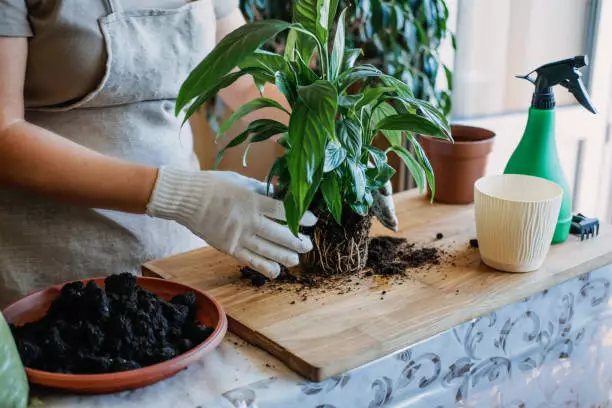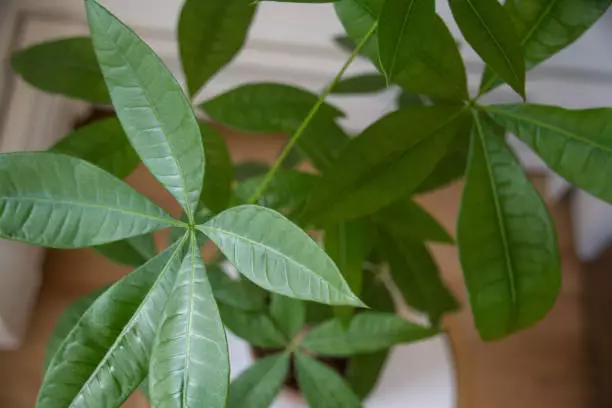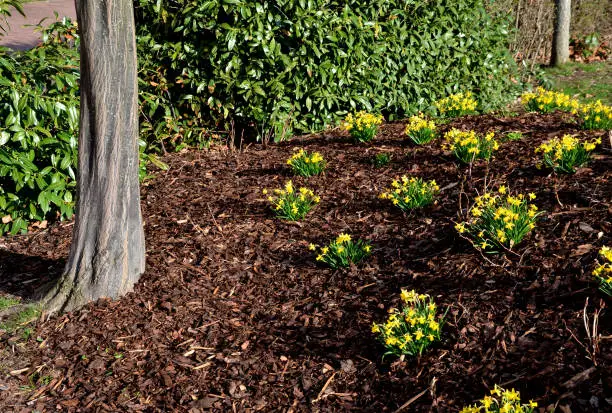Drooping peace lily leaves can mean quite a few problems in that pot. Wilting can appear as though the plant is dying, but if you can still revive it and make the leaves stand erect again.
A drooping peace lily is a sign of underwatering or overwatering. Root rot disease, too much sun, or repotting shock can also cause the Spathiphyllum to wilt. To revive a droopy peace lily, improve drainage in the pot, water adequately but not in excess, or repot the plant to get rid of the fungus.
Is a droopy peace lily dying?
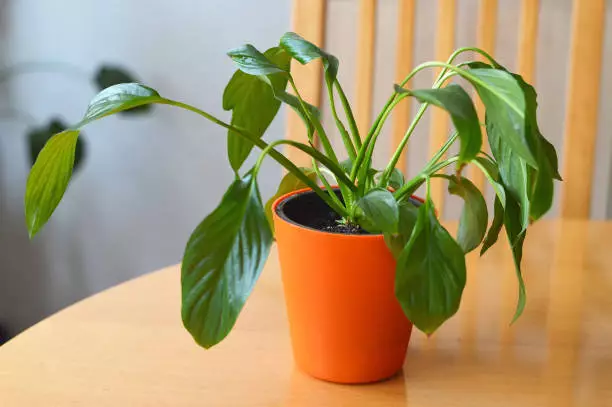
When the leaves of your peace lily start to droop, it does not mean the plant is dying. Droopy leaves are sometimes a sign of drought which can be fixed by keeping the soil moist at all times. Peace lilies like partial shade and so when placed in direct sunlight can easily die due to lack of moisture.
A great way of knowing the peace lily is dying is to check the bottom leaves. If they’re drooping and turning yellow, the plant is dying from lack of water and too much sunlight.
You want to move your indoor plant to a darker area away from too much sun exposure to reduce water loss and stress.
5 Causes of a droopy peace lily
It is very easy to imagine that wilting and droopy leaves of a peace lily are a sign the plant needs water. While that may be true, there are other reasons why the leaves of such indoor plants may start to wilt.
Here are the 5 possible causes of a droopy peace lily:
1. Overwatering
Overwatering causes waterlogging in the soil, making it difficult for the peace lily to breathe and draw in nutrients. The plant’s leaves start to droop especially if the container does not drain water properly. This happens because it is not able to photosynthesize properly due to suffocation.
RELATED: HOW TO REVIVE OVERWATERED PEACE LILY
Common signs of overwatering in peace lilies include:
- Drooping leaves
- Lower leaves turning yellow
- Black-tipped roots
- Brown edges and tips of leaves.
- Dark brown spots on the stalks.
- Slight yellowing of the lower foliage.
Overwatering your houseplants is a dangerous practice. In peace lilies, it can cause diseases such as the various types of root rot including Rhizoctonia root, rot, Phytophthora, Pythium, and Cylindrocladium.
2. Drought
Lack of water will make your peace lily dry out and start to wilt. Drooping leaves are a sign that it’s time to water the plant. If it goes too long without water, the leaves will start to hang due to a loss of moisture.
Signs of lack of water in this houseplant are fairly similar to the signs of an overwatered peace lily. Some leaves may start to turn yellow as they wilt.
Eventually, you may need to prune the affected leaves of your peace lily to help your peace lily resurrect or revive.
RELATED: HOW TO PRUNE PEACE LILY PLANT
Peace lily plants are fairly forgiving if you don’t water them properly. The leaves will soon start to droop when the plant dries out, but when watered they will rebound pretty fast.
When I’ve failed to water my peace lily, I sometimes find the leaves hanging over the pot, but that never worries me. It is just amazing how dry the peace lily can get. When I water it, the lily thrives again within a very short time.
3. Too much sun
A peace lily will start to wilt and droop when exposed to too much sun. For the plant to thrive well, it requires partial sunlight or even low light conditions. If you expose the plant to too much direct sun, the foliage will start to droop and show signs of burning.
Leaves start to droop because the rate of transpiration is much higher than normal. The plant loses water too quickly, making its leaves start to droop and wilt.
4. Root rot
Root rot may be one of the reasons why your peace lily is droopy. When plants sit in excess water for long, the roots will be too wet, leading to root rot disease.
Signs of root rot may include the following:
- Yellowing leaves
- Wilting leaves
- Mushy, weakened, and rotting roots
- Roots turning black
If the wilting is persistent, you might want to change the soil because it is already infested with a fungus.
5. Repotting shock
Did you transplant your peace lily? After repotting, it is normal for houseplants to suffer from shock and show signs such as drooping and wilting. During this time, it is best not to water the plant (unless the soil is completely dry) or feed it with fertilizer.
Common symptoms of peace lily shock are:
- Wilting leaves
- Leaf rolling and curling in peace lilies
- Yellowing of leaves
If you do not remedy the stress, your houseplant may observe leaf death that may be followed by limb and twig death as well.
How to revive a drooping peace lily
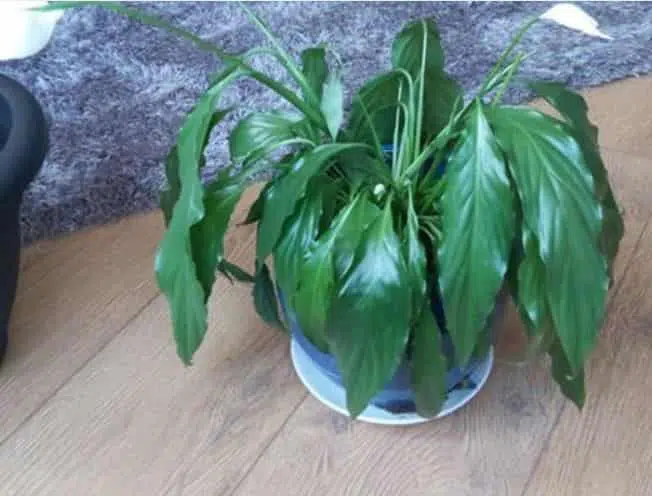
1. Drain the soil
Drain the potting soil if you have identified the problem to be excess water causing drainage problems. It is very easy to fix this one:
Simply create some holes in the base of the plant’s pot. You’ll notice water flowing out when in excess and the peace lily will revive fast.
Peace lilies are water-thirsty plants and can do well as long as the water can drain through holes at the bottom of the pot.
However, if you leave them in excess water, they will start to wilt pretty fast because of the lack of air in the roots.
Pro tip: You can test for this by pushing your finger into the potting soil up to the second knuckle. If it comes up too wet, then there’s a waterlogging problem.
2. Water the peace lily on time
Did you know that when blooming, peace lilies require a little more water than normal? This can make the plant wilt quite easily when left without water for a long time.
To revive your peace lily, water at least once a week to keep the soil moist and prevent wilting. In the summer, spritz the leaves every other day with distilled water to reduce water loss through the plant’s leaves.
3. Move the peace lily away from direct sunlight
An excessively transpiring peace lily will keep drooping even with adequate watering and feeding. To fix the drooping caused by excess sunlight, move the plant to a shady area. For example, if you’ve placed the pot near the window, move it away into a partially lit area.
If the lily is out on the patio where there is direct sunlight, you might want to move it to a place where there’s less sunlight to stop the peace lily from wilting.
Pro tip: Choose a spot in your house or garden that is bright but does not receive direct sunlight if you want to grow healthy peace lilies with deep green leaves. Shady corners in the patio are always a great place for peace lilies.
4. Treat root rot
Root rot is a fungal infection that can easily be treated. If unhealthy roots are causing drooping in Spathiphyllum, you might want to do a complete treatment of the soil, roots, and even water.
RELATED: HOW TO TREAT POTHOS ROOT ROT
Here’s how to treat root rot and revive your peace lily:
- Change the potting soil completely to get rid of the soil with the fungus in it.
- Sterilize the potting container. You can use hydrogen peroxide to clean it and kill the fungus.
- Trim the rotting roots on the peace lily to prevent infecting the healthy roots.
- Clean off the roots to get rid of any fungal spores.
- Repot the plant in a healthy potting mix.
After repotting, you might notice the plant having a little stress. This is normal, so allow it a few days to revive and grow healthy again.
5. Treat with vitamin B1 when repotting
When the problem is droopy leaves after transplant, you may need to start repotting your peace lilies with the treatment of vitamin B1 to help with root development.
An alternative is a starter fertilizer for houseplants to help with root development. Be careful not to apply too much fertilizer to your houseplants as it can also cause burning and intoxication especially if you feed with nitrogen fertilizer.
Frequently ask questions
Here are some of the commonly asked questions about peace lilies and ways to revive them when they wilt:
Why does my peace lily droop even after watering?
Drooping peace lily leaves after watering is a sign of overwatering. Too much water drowns the plant, making it difficult to breathe because there aren’t any air pockets in the soil. To fix this, you might want to remove the plant from its pot and drain most of the water from the soil.
After removing the peace lily from the waterlogged soil, you might want to check the roots for root rot.
If there are signs of root rot fungus such as browning and softening, trim off the affected roots before repotting the plant to avoid any further drooping even after watering.
Why is my peace lily drooping after repotting?
Your peace lily may start drooping after repotting because it is in shock, does not have enough water, or there’s too much water. Soggy soil after watering causes waterlogging and impairs water and nutrient absorption, making it droop after repotting. Shock may also lead to drooping after transplanting or changing the pot.
If you just repotted your plant, make sure the soil is moist but not too wet. That should be enough to revive the indoor plant but if it starts to wilt again, try watering to make sure the soil does not remain dry for a long time.
If you just transplanted your peace lily, it is best to treat the transplant shock by feeding it with vitamin B1. B1 vitamin will help prevent repotting shock of your peace lily and stimulate new root growth in just about any tender plant.
Peace Lilies are usually drama queens. When droopy, water usually helps, but don’t overwater. Water but don’t let it be soggy nor sit in water. If you just watered it, there is no need to water it again. Make sure when you water it, you give it a good watering each time and let the water drain out of the bottom. Make sure it has drainage holes. Also, if it is root bound, then she will keep drooping EVERY time after your water. Check the roots and make sure it isn’t root-bound. If it is, report in a pot that’s 2 inches bigger with some fresh soil. But yeah, they do droop and that’s how you can tell she’s thirsty.
Alex K. Worley
References:
[1] University of Vermont: Department of Plant and Soil Science: EASY HOUSEPLANT – THE PEACE LILY
[2] University of Vermont: Department of Plant and Soil Science: Watering Houseplants Properly
[3] Purdue University, Cooperative Extension Service: Transplant Shock of Trees and Shrubs

